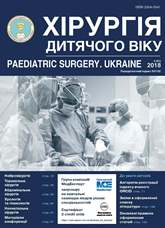Experience of using vacuum-therapy in thoracic surgery
DOI:
https://doi.org/10.15574/PS.2018.61.55Keywords:
purulent thoracic surgery, vacuum therapy, ultrasonic cavitationAbstract
Objective: to analyse the possibilities of using the vacuum therapy (VAC therapy) for purulent lesions of the chest wall and pleural cavity.
Materials and methods. In total 16 patients were treated for purulent thoracic pathology using VAC therapy. Group I included 7 patients with osteomyelitis
of the sternum after sternotomy, Group II comprised 5 patients with purulent lesions of the thoracic cavity, Group III – 4 patients with gunshot penetrating
wounds of the chest after thoracotomy with thoracostomy and pleural empyema.
The effect of VAC therapy and ultrasonic cavitation on the wound process was compared based on the evaluation of microbial contamination degree and
changes in the wound cellular composition: VAC therapy with ultrasonic cavitation was used in 9 patients and VAC therapy alone was used in 7 patients.
Results. It was shown a faster decrease in the microbial contamination level as well as faster development of reparative processes in wound under the influence
of ultrasonic cavitation in combination with VAC therapy (p<0.05) versus using the VAC therapy alone. Total mortality made up 2 (12.5%) cases.
Conclusions. The VAC therapy employment in purulent thoracic surgery is an efficient modern approach to the treatment of this difficult category of patients,
particularly when coupled with ultrasonic cavitation and antibacterial therapy.
References
Gorbunov VA, Georgikia RK, Mukharyamov MN, Vagizov AI. (2016). The tactics of conducting poststernotomous mediastinitis in cardio-surgical patients. Surgery. 11(2): 41–5.
Korymasov EA, Pushkin SY, Benyan AS, Medvedchikov-Ardia AI. (2015). Strategy and tactics of surgical treatment of infectious complications after sternotomy. Wounds and wound infections. The prof. B.M. Kostyuchenok Journal. 2(4): 15-25.
Protasevich AI, Tatur AA. (2016). The effectiveness of vacuum therapy in the treatment of postoperative sternomediastinitis: systematic review and meta-analysis. Surgery news. 24(3): 275–284.
Ruzmatov TM, Efendiyev VU, Boboshko AV, Malakhov EU, Nesmachny AS, Razumakhin RA, Kareva YuE, Chernyavsky AM. (2015). Vacuum therapy of postoperative sternomediastinitis. Surgery. 8: 14–17.
Furgal AA, Shchava SP, Kapustin MA, Polkina LN, Silaev AA, Sorokin VA. (2017). The use of vacuum therapy in the treatment of postoperative sternomediastinitis: the first experiment. Pacific Medical Journal. 2: 77–9.
Begum SS, Papagiannopoulos K. (2012). The use of vacuumassisted wound closure therapy in thoracic operations. Ann Thorac Surg. 94(6): 1835–9. https://doi.org/10.1016/j.athoracsur.2012.08.009; PMid:23122932
Byun CS, Choi JH, Hwang JJ, Kim DH, Cho HM, Seok JP. (2013). Vacuum-assisted closure therapy as an alternative treatment of subcutaneous emphysema. Korean J Thorac Cardiovasc Surg. 46(5): 383–7. https://doi.org/10.5090/kjtcs.2013.46.5.383; PMid:24175278 PMCid:PMC3810565
de Abreu IR, Pontes EP, Tamagno MF, Sardenberg RA, Younes RN, Abrao FC. (2014). Treatment of thoracic wounds with adapted vacuum therapy. Asian J Surg. 37(1): 49–52. https://doi.org/10.1016/j.asjsur.2013.07.015; PMid:24026077
De Caridi G, Serra R, Massara M, Barone M, Grande R, Butrico L, Mastroroberto P, de Franciscis S, Monaco F. (2016). VAC therapy for the treatment of complex wounds after cardio-thoracic surgery. Int Wound J. 13(5): 759–62. https://doi.org/10.1111/iwj.12369; PMid:25229399
Hayashi S, Takahashi N, Yasuda S, Ishibashi K, Kitada M, Kyobu G. (2016). Post-pneumonectomy Empyema Successfully Treated with Negative Pressure. Wound Therapy. 69(3): 188–90.
Hofmann HS, Schemm R, Grosser C, Szoke T, Sziklavari Z. (2012). Vacuum-assisted closure of pleural empyema without classic openwindow thoracostomy. Ann Thorac Surg. 93(5): 1741–2. https://doi.org/10.1016/j.athoracsur.2011.12.039; PMid:22541219
Hofmann HS. (2013). Modern management of empyema thoracis. Semin Thorac Cardiovasc Surg. 25(4): 287–91. https://doi.org/10.1053/j.semtcvs.2013.07.006; PMid:24673957
Laperuta P, Napolitano F, Vatrella A, Di Crescenzo RM, Cortese A, Di Crescenzo V. (2014). Post-pneumonectomy bronchopleural fistula successfully closed by open-window thoracostomy associated with V.A. C. therapy. Int J Surg. 12(2): 17–19. https://doi.org/10.1016/j.ijsu.2014.08.390; PMid:25159544
Sjogren J, Malmsjo M, Gustafsson R, Ingemansson R. (2006). Poststernotomy mediastinitis: a review of conventional surgical treatments, vacuum-assisted closure therapy and presentation of the Lund University Hospital mediastinitis algorithm. Eur J Cardiothorac Surg. 30: 898–905. https://doi.org/10.1016/j.ejcts.2006.09.020; PMid:17056269
Sziklavari Z, Ried M, Neu R, Schemm R, Grosser C, Szoke T, Hofmann HS. (2015). Mini-open vacuum-assisted closure therapy with instillation for debilitated and septic patients with pleural empyema. Eur J Cardiothorac Surg. 48(2): 9–16. https://doi.org/10.1093/ejcts/ezv186; PMid:26017017
Sziklavari Z, Grosser C, Neu R, Schemm R, Kortner A, Szoke T, Hofmann HS. (2011). Complex pleural empyema can be safely treated with vacuum-assisted closure. J Cardiothorac Surg. 6: 130. https://doi.org/10.1186/1749-8090-6-130; PMid:21978620 PMCid:PMC3205023
Sziklavari Z, Grosser C, Neu R, Schemm R, Szoke T, Ried M, Hofmann HS. (2013). Minimally invasive vacuum-assisted closure therapy in the management of complex pleural empyema. Interact Cardiovasc Thorac Surg. 17(1): 49–53. https://doi.org/10.1093/icvts/ivt093; PMid:23536021 PMCid:PMC3686375
Sziklavari Z, Ried M, Hofmann HS. (2014). Vacuum-assisted closure therapy in the management of lung abscess. J Cardiothorac Surg. 6; 9: 157.
Sziklavari Z, Ried M, Hofmann HS. (2015). Intrathoracic Vacuum-Assisted Closure in the Treatment of Pleural Empyema and Lung Abscess. Zentralbl Chir. 140(3): 321–7. PMid:25906022
Downloads
Issue
Section
License
The policy of the Journal “PAEDIATRIC SURGERY. UKRAINE” is compatible with the vast majority of funders' of open access and self-archiving policies. The journal provides immediate open access route being convinced that everyone – not only scientists - can benefit from research results, and publishes articles exclusively under open access distribution, with a Creative Commons Attribution-Noncommercial 4.0 international license(СС BY-NC).
Authors transfer the copyright to the Journal “PAEDIATRIC SURGERY.UKRAINE” when the manuscript is accepted for publication. Authors declare that this manuscript has not been published nor is under simultaneous consideration for publication elsewhere. After publication, the articles become freely available on-line to the public.
Readers have the right to use, distribute, and reproduce articles in any medium, provided the articles and the journal are properly cited.
The use of published materials for commercial purposes is strongly prohibited.

